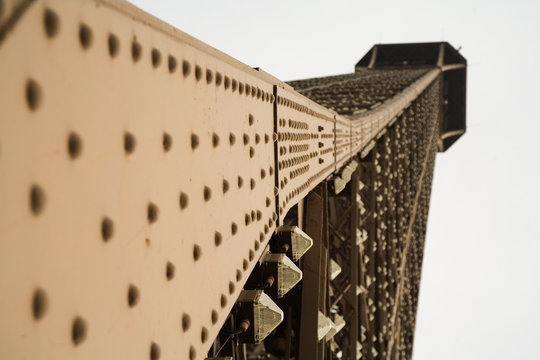Shear
In mechanical engineering, shear refers to a type of stress that occurs when forces are applied parallel to opposing surfaces of a material, causing it to deform or fail by sliding or tearing along those surfaces. Shear stress arises when two layers of material or particles slide past one another in opposite directions. This phenomenon can occur in various materials, including solids, fluids, and gases.
What do you see in the picture? I hope you recognized rivets. Did you know that the Eiffel Tower was constructed using rivets? Do you know that shear stress occurs precisely in riveted joints? Such stress also occurs in bolted joints, as well as in some welded joints.
Photo from https://stock.adobe.com/hr/search?k=effel.

The importance of shear in mechanical engineering.
The importance of shear in mechanical engineering is significant for several reasons:
- Structural Integrity: Shear forces play a crucial role in determining the structural integrity of mechanical components and systems. Understanding shear stresses and strains is essential for designing structures that can withstand external loads without failure.
- Material Behavior: Shear helps engineers understand how materials deform and fail under applied loads. Different materials exhibit different shear properties, and studying shear behavior is essential for selecting appropriate materials for specific applications.
- Design Optimization: By analyzing shear forces, engineers can optimize the design of mechanical components to minimize stress concentrations and improve overall performance. This includes designing features such as fillets, chamfers, and reinforcement ribs to redistribute shear forces and enhance structural strength.
- Failure Analysis: Shear plays a crucial role in failure analysis, helping engineers identify potential failure modes and develop strategies to prevent catastrophic failures. By analyzing shear stresses and strains, engineers can anticipate failure mechanisms and implement appropriate mitigation measures.
- Fasteners and Joints: Shear forces are particularly important in the design of fasteners and joints, such as bolts, rivets, and welds. Understanding shear stress distributions in these connections is essential for ensuring their stability and longevity under various loading conditions.
- Fluid Mechanics: In fluid mechanics, shear forces are fundamental to understanding fluid flow behavior, particularly in viscous fluids. Shear stress influences fluid viscosity, flow resistance, and boundary layer formation, which are critical factors in designing fluid systems and hydraulic machinery.
- Manufacturing Processes: Shear forces are also relevant in various manufacturing processes, such as cutting, shearing, and forming. Understanding shear behavior helps optimize manufacturing techniques and improve the quality and efficiency of production processes.
Overall, shear is a fundamental concept in mechanical engineering that influences the design, analysis, and performance of mechanical systems across various industries. By understanding and effectively managing shear forces, engineers can develop safer, more reliable, and more efficient mechanical solutions.
Learn about the shear stress, τ (tau).
The video demonstrates a practical example calculation loaded with shear stress.
The video demonstrates a practical example calculation loaded with shear stress.
Answer the questions.
Resource information